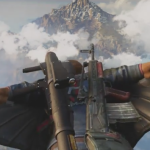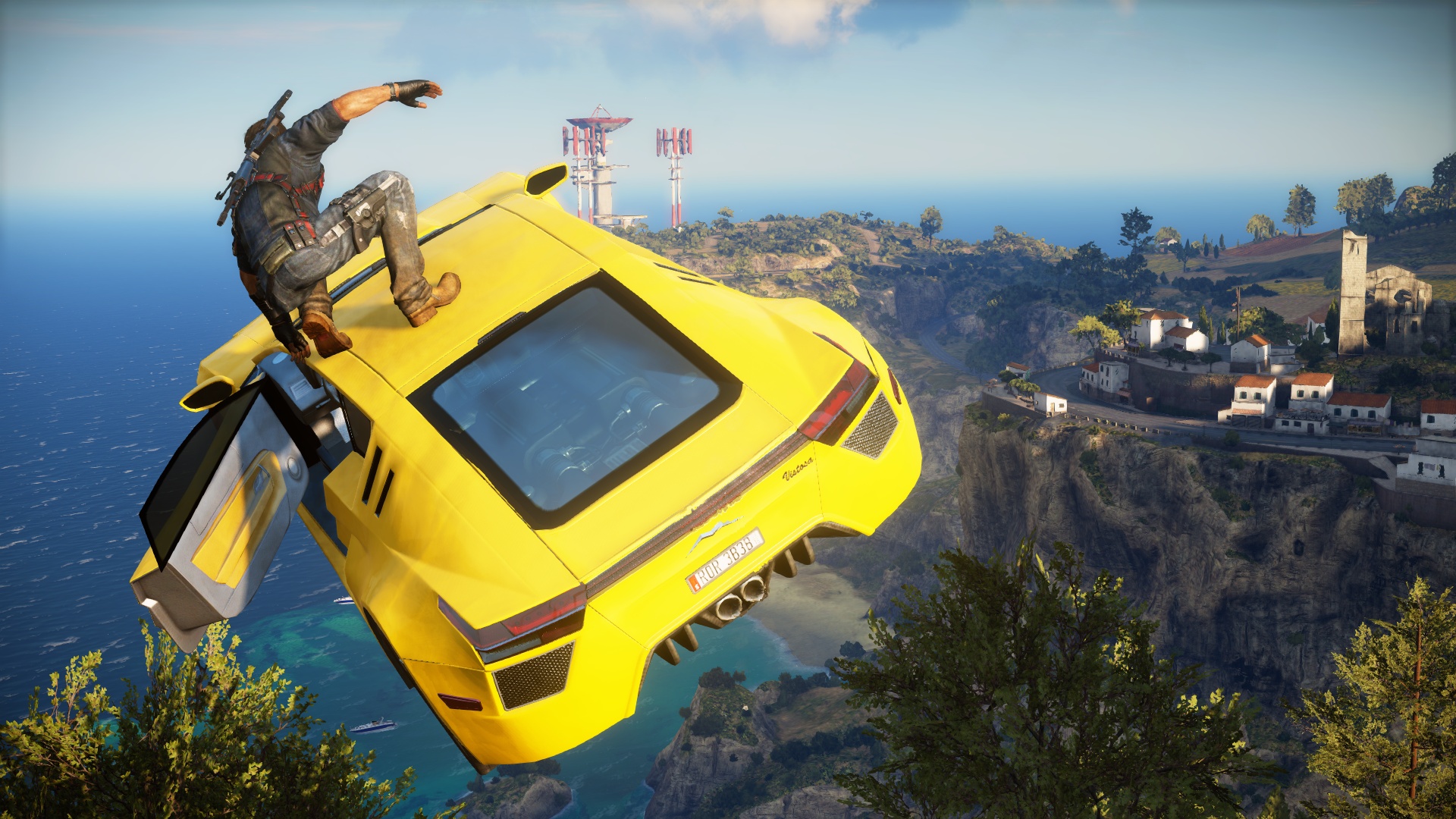The week after Thanksgiving should normally be the time when you start to put up the Christmas lights all over your house and any trees that you want to bring inside, but for action gamers everywhere Square Enix is inviting you to light it up in a different way.
This week Avalanche Studios, the studio that brought you Mad Max, released the third installment in their Just Cause series. This time Rico Rodriguez is coming home — and he’s bringing the fireworks with him.
The story for Just Cause 3 is so bare-bones that it might as well be an old NES title screen with a block of text. Rico comes home to discover a cartoony dictator, that’s one part the dude from Tropico and one part Fidel Castro, has taken over Rico’s homeland of Medici — which in itself is a cartoony version of a Spanish town in Greece (read: somewhere Mediterranean). As previous Just Cause players will know, the story isn’t really where the games have shined before; and it’s new, silly approach is a little less cringe-worthy that how serious Just Cause 2 tried to treat itself. In a much more fleshed out game, the lack of a compelling narrative wouldn’t be so obvious.
Unfortunately, Just Cause 3 ends up being a decently designed vehicle of destruction that has nowhere to go.
Game journalists should be thanking Avalanche. Now we have another go-to example when we describe open world games versus sandbox. Sure, Just Cause 2 could have been just as good of an example, but only players with modded games on PC would actually understand the reference. Avalanche took the more famous mods that people were using in JC2 and built them into JC3. With just a few new enhancements to what made the modded Just Cause 2 so fun in the first place, there are several ways to create your own unique gaming experience. Rico can now deploy multiple tethers and tethers can be retracted, so any two items that are attached can be flung together. This helps separate JC3 from the rest its open world peers by giving players more potential for creative enemy dispatching. If two helicopters are harassing you from above you can either grapple to one and hijack it, tether both of them together and retract the tether — making them hilariously crash into each other, or tether one to the ground while shooting a rocket at the other one. Options like these are almost necessary to keep the grind of capturing territories back from mini-Castro from getting too monotonous too fast. But monotony will get there. Eventually.
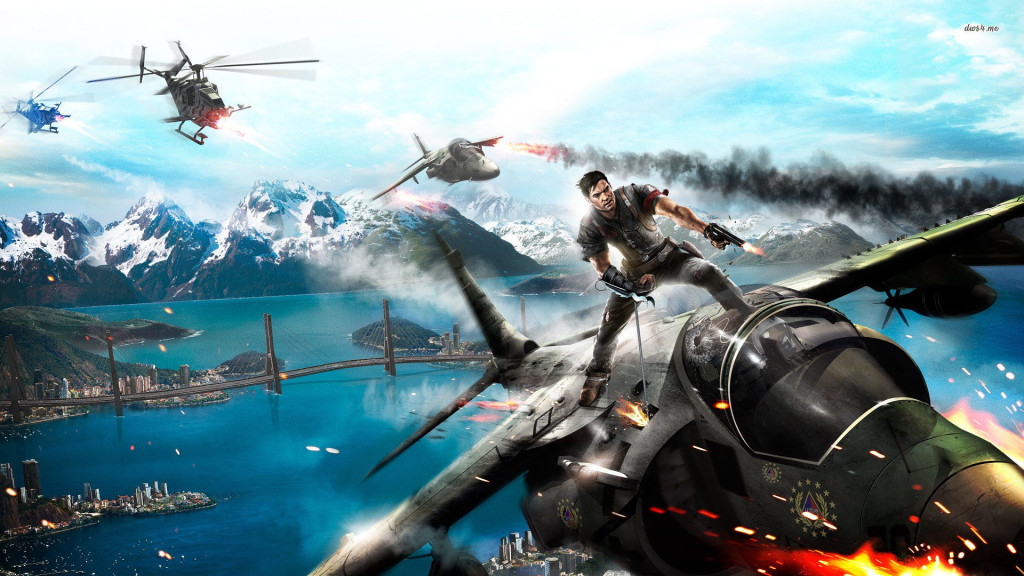
Just like the narrative itself, the story missions are just MacGuffins to get you to the exploding. They’ll range from destroying a set of tanks to searching for shipping containers at a hostile base for a particular object. And guess what you’ll be doing at the base while you’re looking? You guessed it!
Exploding things.
Thankfully the simplicity to each objective caters to everyone’s preference in gameplay. In a mission where you and an ally have to escort a defector you have the choice in either manning a mini-gun on your ally’s jeep, attaching yourself to the underbelly of the defector’s helicopter, or just Batman-ing it alongside the two while you rain death from above. Now that I think about it, I might have just been able to tether the person we were escorting to the helicopter and just dragged him out of there myself.
Between story missions there isn’t much to do in this huge, 400 square mile map besides taking over territories and completing challenges. Doing the former in this particular game is a little more involved than in games like Far Cry or Assassin’s Creed before it.
–Just as it was in JC2, accomplishing this task depends on chaos — except now it’s more controlled. If you want to take over a city for the rebellion there are a few scavenger-hunt-type tasks that you must perform (e.g. destroying billboards, calling in rebel support, taking out statues, or even killing important militia soldiers).
–Just like all the murdering and exploding you’ll do, all these mini-objectives can be completed in different ways; the problem is that exact locations for anything won’t appear on your map. You’ll end up flying around the first few towns you liberate numerous times before you get used to what you’re looking for and once you get used to it, and new objectives are introduced, any frustration just reemerges.
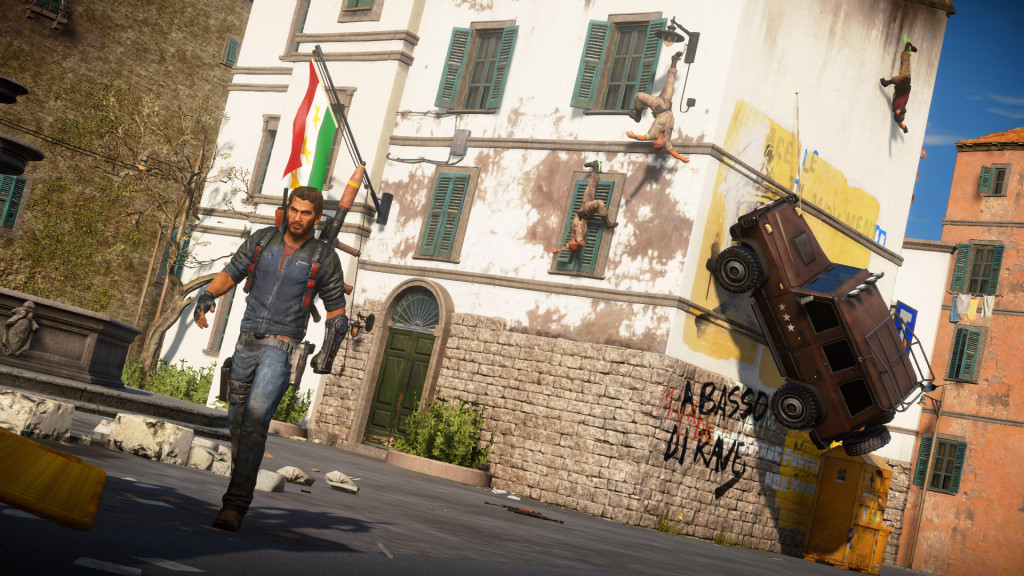
The challenges in the game are just like they are in any other game, except for the fact that they’re the only way to upgrade any of your gear throughout the game since there is no in-game currency. Fortunately the upgrades are tied to whatever the challenge you select is. So if you want to upgrade your brand new wingsuit, you’ll have to try and fly through as many hoops as possible with your wingsuit. Upgrades aren’t totally necessary for completing the game, as anyone could be creative enough to tackle even the toughest armies with your stock armament, but they do unlock equipment abilities that will significantly alter the overall game play. Most challenges, and even some story missions, are gated behind enemy territory, and you’ll have to conquer those positions on the map to unlock them.
–Just like in Just Cause 2 there are some surprises to be had — some worse than others. The only other respite from challenges, story missions, and capturing territories will be random encounters (ala Grand Theft Auto) that range from assassinations to towing cars that are out of gas. These encounters are actually more creative than the challenges and are a glimpse into game play variations that legitimate side missions should have provided. Other fun surprises that you’ll be hearing more of on the internet as players get into the game will be whatever Easter eggs Avalanche put into this particular game, not unlike finding the island from Lost in Just Cause 2. So far Thor’s hammer has been found on the game map and possibly even a Stargate.
The not-so-exciting surprises come in the form of random framerate drops that happen on the console versions of the game. There’s also unpredictable loading times. When trying to beat my score on a particular challenge I’d get anywhere from 30 second to 4 minute loading times – for the same challenge.
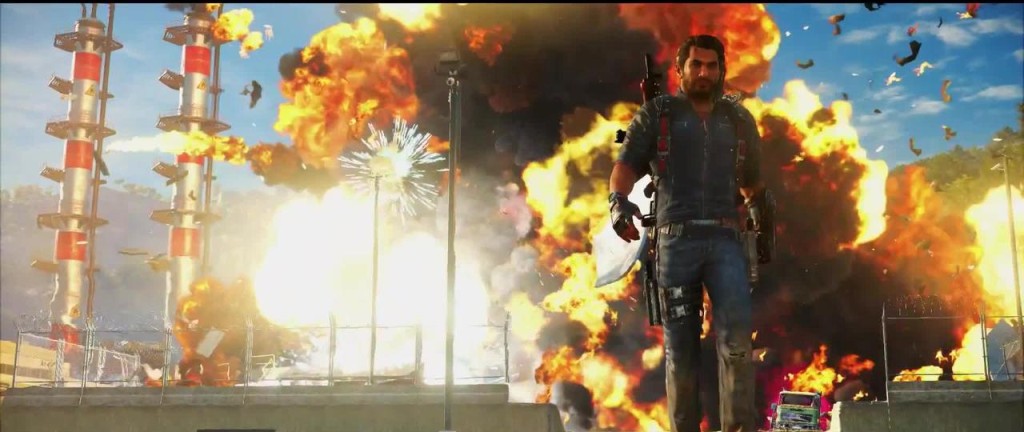
Despite an equally rocky launch, to this day Just Cause 2 still goes on sale on Steam, and dozens of gamers will still snatch the 5-year game up. According to Steam, I’ve put in 20 hours into the game — and I haven’t even completed a single non-tutorial mission. Thanks to some mod support, most notably (other than the tethering mods mentioned above) the Just Cause 2 Multiplayer mod. Avalanche made a note at E3 to let people know that a lot of the changes in the game were happening because of what was being made on Steam. It seems like they failed to realize that those mods were happening because what was given to the players right out of the box was sorely lacking.
Just Cause 3 was a chance to remedy that, but is unfortunately a tether too short.
